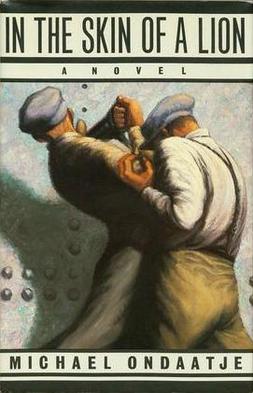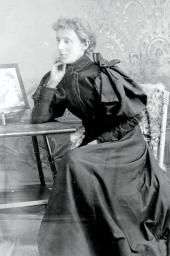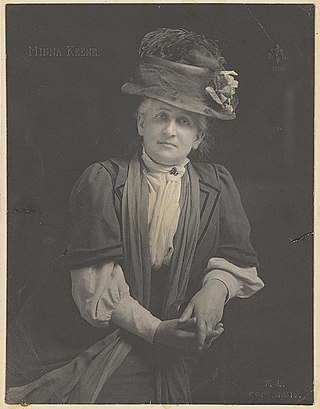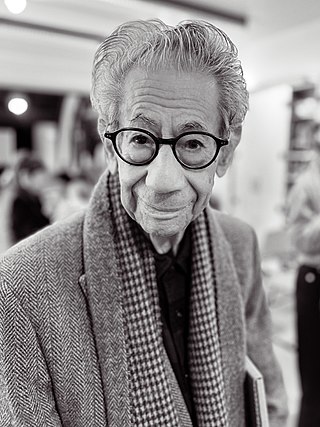Arthur S. Goss, also known as William Arthur Scott Goss (1881-1940) was the City of Toronto's first official photographer. [1]
Arthur S. Goss, also known as William Arthur Scott Goss (1881-1940) was the City of Toronto's first official photographer. [1]
William Arthur Scott Goss was born in London, Ontario on 4 March 1881, moving to Toronto in 1883, where his father, John Goss, worked in the newspaper and publishing industries. [2] When his father died, Goss, age 10, began work as an office boy in the city engineer's office. He was promoted to clerk of street repairs in 1899 and worked as a clerk and a draughtsman for nearly twenty years. Then, in 1911, he was promoted to head of the photography and blueprinting section and became the city of Toronto's first official photographer. [3] [4]
Working until his death in 1940, Goss made photographs for a range of municipal departments. Some of his best-known images were taken for the Works and Health Departments. For the Works Department, he photographed street cleaning, the construction of new roads, and major infrastructure projects, such as the city's new hydroelectric system and the Bloor Viaduct. His photographs of street grading and widening, bridge, underpass, and sewer construction, street cleaning, and garbage disposal were used as records to assist with the routine business of the Works Department, which, at the time, was focused on improving the physical environment of the city. [5]
Medical Health Officer Dr. Charles Hastings enlisted Goss's help in his crusade to improve public health. Goss photographed unsanitary and overcrowded conditions for the Health Department, and Hastings used Goss's photographs as evidence in his 1911 report on slum conditions. Many of Goss's photographs for the Health Department were never published, but were used internally to identify problems, to track the progress of particular projects, or to report on new technologies and methods for carrying out the Department's work. With Goss as the city photographer, photographs quickly became an important resource in many aspects of Toronto's municipal government. [5]
Goss was a member of the Toronto Camera Club and active within the pictorialist movement. [2] The artist intended to help create a national network of photographers, and was also associated with the Arts and Letters Club, with which he staged a number of exhibitions in the 1910s. [2] Modeled after the Group of Seven, Goss hoped to develop distinctly Canadian style within global photography. [2] Though the Arts and Letters Club was ultimately unable to achieve a similar level of fame, it managed to connect leading figures in Canadian Art including A.Y. Jackson, F.H. Varley, and Harold Mortimer-Lamb. [2]
He explored customary pictorialist subject matter, such as portraits and landscapes, and experimented with the characteristic soft-focus style of pictorialism. [2] Like others associated with the movement, Goss aimed to produce aesthetically pleasing images and viewed his artistic practice as a form of personal expression. He organized exhibitions of art photography and won awards for his own photographs, which were shown at exhibitions in Canada and England. [6] [5]
There are approximately 26,000 negatives in the Arthur Goss collection at the City of Toronto Archives. These negatives were found in the attic of old City Hall and were catalogued by city archivists in the 1960s. [3]
Canadian writer Michael Ondaatje relied on Goss′s photographs when researching his novel In the Skin of a Lion about the immigrant and working class experience in early 20th Century Toronto. Ondaatje decided to include Goss as a character in this novel. [7] Following the interest in Goss, following the publication of Ondaatje′s novel, the City of Toronto Archives developed a special lecture and tour, tailored for students, addressing the role of Goss′s photos in Ondaatje's book. [8]
Goss's duties included providing a visual record of the health and social problems posed by urban poverty. [9] Scholars have compared Goss's photographs of urban poverty to those of Jacob A. Riis and Lewis W. Hine.
Decades after his death, his work is celebrated, in several books collecting his photographs, and in magazine profiles. [10] [11] [12]

In the Skin of a Lion is a novel by Canadian–Sri Lankan writer Michael Ondaatje. It was first published in 1987 by McClelland and Stewart. The novel fictionalizes the lives of the immigrants who played a large role in the building of the city of Toronto in the early 1900s, but whose contributions never became part of the city's official history. Ondaatje illuminates the investment of these settlers in Canada, through their labour, while they remain outsiders to mainstream society. In the Skin of a Lion is thus an exposé of the migrant condition: "It is a novel about the wearing and the removal of masks; the shedding of skin, the transformations and translations of identity."

William Notman was a Scottish-Canadian photographer and businessman. The Notman House in Montreal was his home from 1876 until his death in 1891, and it has since been named after him. Notman was the first photographer in Canada to achieve international recognition.

William James Topley was a Canadian photographer based in Ottawa, Ontario. He was the best known of Ottawa’s nineteenth-century photographers and the most socially prominent one. Topley was noted for his portraiture of Canadian politicians and was a business partner of William Notman, having taken over Notman's Ottawa studio in 1872. A large number of photographs by Topley are now in the collection of Library and Archives Canada, including approximately 150,000 glass plates negatives and a set of 66 index albums covering the entire history of his Ottawa studios from 1868 until 1923.

Peter Pitseolak (1902–1973) was an Inuk photographer, sculptor, artist and historian. Pitseolak was Baffin Island's first indigenous photographer.
Richard Harrington, was a Canadian photographer. He is best known for his photographs taken in the Canadian Arctic between 1948 and 1953, including his iconic shot of the 1950 Caribou Inuit famine and his 1949 photograph of Helen Konek.
Fred Herzog D.F.A. was a German-born Canadian photographer, who devoted his artistic life to walking the streets of Vancouver as well as almost 40 countries with his Leica, and various Nikon, Kodak and Canon, photographing - mostly with colour slide film - his observations of the street life with all its complexities. Herzog did not achieve critical recognition until the 1990s, when his unusual early use of colour in art photography was recognized. He became celebrated internationally for his pioneering street photography, his understanding of the medium combined with, as he put it, "how you see and how you think" created the right moment to take a picture.

Jules-Isaïe Benoît Livernois was a businessman and photographer from Lower Canada.

Edith Sara Watson was a photographer whose career spanned the 1890s through the 1930s. She is best known for her photojournalistic images of everyday life, working people, and women, particularly in Canada.
Samuel Bejan Tata was a Chinese photographer and photojournalist of Parsi descent. Tata grew up in Shanghai where he learned the basics of photography from several mentors including Lang Jingshan and Liu Xucang. Due to political unrest, he mostly confined himself in his early career to portraiture in the tradition of pictorialism.

Jessie Tarbox Beals was an American photographer, the first published female photojournalist in the United States and the first female night photographer.

Geraldine Moodie was a Canadian photographer who pioneered in capturing photos of early Canadian history. She is best known for her work with indigenous peoples in Northern Canada. Moodie is one of Canada's first professional female photographers. She opened photography studios in Battleford, Saskatchewan (1891), Maple Creek (1897), and Medicine Hat, Alberta (1897).

William James was an early and prolific photographer who chronicled Toronto, Ontario. His works have been widely collected and republished. James came to Canada, from England, in 1906, when he was forty years old. He and his wife immigrated with five children and seven dollars to their name.

Harold Mortimer-Lamb was an Anglo-Canadian mining engineer, journalist, photographer, and artist perhaps best known for championing the Group of Seven in the 1920s. He was the father of New Brunswick artist Molly Lamb Bobak.

Minna Keene, née Töneböne, was a German-born, self-taught Canadian pictorial portrait photographer, considered "hugely successful".
Rosemary Gilliat was an English photojournalist who traveled across Canada, documenting people and events for publications such as Weekend magazine and the National Film Board of Canada.
Jeff Thomas is an Onondaga Nation photographer, curator, and cultural theorist who works and lives in Ottawa, Ontario.
John Vanderpant was a Dutch-Canadian photographer, gallery owner and author. He made his living doing portrait work while becoming known as a major member of the International Modernist photography movement in Canada. He was a key figure in Vancouver's artistic community.

Arthur Beales (1871-1955) was the first official photographer for the Toronto Harbour Commission, first hired in 1914, and only retiring in 1951. His job was physically challenging, as he climbed cranes and towers, carrying the heavy and inconvenient cameras of the time.

Gabor Szilasi is a Canadian artist known for the humanist vision of his social-documentary photography.
Michel Lambeth was a Canadian photographer. He made an in-depth photographic study of Toronto during the 1950s and was one of the country's leading photo-journalists during the 1960s.
In the tunnel under Lake Ontario two men shake hands on an incline of mud. Beside them a pickaxe and a lamp, their dirt-streaked faces pivoting to look towards the camera. For a moment, while the film receives the image, everything is still, the other tunnel workers silent. Then Arthur Goss, the city photographer, packs up his tripod and glass plates, unhooks the cord of lights that creates a vista of open tunnel behind the two men, walks with his equipment the fifty yards to the ladder, and climbs out into sunlight.
On a visit to the City of Toronto Archives, students will see archival photographs recording the construction of the Bloor Street Viaduct and the R. C. Harris filtration plant, the two major settings in In the Skin of a Lion.
According to Ralph Greenhill and Andrew Birrell, the photographs of Jacob A. Riis in the slums of New York, and Lewis W. Hine's pictures of child labour in the United States are well known, but work of Goss in Toronto has received little recognition'.
In fact, Goss was pretty much everywhere during the early 20th century in Toronto, having produced over 35,000 images over his 37-year career as City Photographer. Along with the construction of the filtration plant and various pumping stations, other noteworthy projects he documented included the Bloor Viaduct, the Municipal Abattoir, and TTC trackwork across the city.